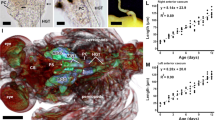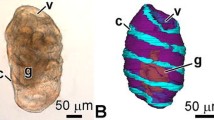Abstract
Ultrastructural differences are shown between the caecal organization in three blood-feeding polyopisthocotylean monogeneans, i.e., the chimaericolid Chimaericola leptogaster from the holocephalan Chimaera monstrosa and two hexabothriids, Callorhynchocotyle callorhynchi from the holocephalan Callorhynchus capensis and Rajonchocotyle emarginata from the elasmobranch Amblyraja radiata. In C. leptogaster, digestive cells and connecting syncytium, joined close to the luminal surface by septate junctions, are arranged alternately along the caecal epithelial wall; the nuclear regions of both cell types are sunk below the general level of the caecal epithelium; a concave depression on the apical margin of the digestive cells bears lamellae; and this depression is covered by a lamellate bubble formed by thin projections emanating from the connecting syncytium. The luminal surface of the connecting syncytium is covered with outgrowths terminating in the form of long, narrow processes. In R. emarginata and C. callorhynchi, the predominant digestive cells are at different stages of development and occur in groups, developing digestive cells bulge into the caecal lumen from the connecting syncytium with contact sites present close to the luminal surface, and the luminal surface structures of both the connecting syncytium and the digestive cells are short lamellae. In these two hexabothriids, a holocrine (or apocrine) process for the elimination of digestive product is assumed via the detachment of fully differentiated, bulging digestive cells. Free, apparently sloughed digestive cells and residual bodies are present within the caecal lumen, and replacement digestive cells are numerous in the connecting syncytium. In the chimaericolid, free bubbles containing residual bodies and portions of digestive cells filled with degenerating digestive vesicles occur in the caecal lumen along with large amounts of male and female reproductive material. The usefulness of characteristics of the caecal ultrastructure as taxonomic traits at the family level is discussed.






Similar content being viewed by others
References
Allen KM, Tinsley RC (1989) The diet and gastrodermal ultrastructure of polystomatid monogeneans infecting chelonians. Parasitology 98:265–273. doi:10.1017/s0031182000062181
Bogitsh BJ (1993) A comparative review of the flatworm gut with emphasis on the Rhabdocoela and Neodermata. Trans Am Microsc Soc 112:1–9
Brennan GP, Ramasamy P (1996) Ultrastructure of the gut caecal epithelium of Pricea multae (Monogenea: Polyopisthocotylea). Parasitol Res 82:312–318. doi:10.1007/s004360050119
Euzet L, Combes C (2003) Some controversial questions regarding Monogenea. In: Combes C, Jourdane J (eds) Taxonomy, ecology and evolution of metazoan parasites, vol 1. Presses Universitaires de Perpignan, Perpignan, pp 303–320
Fournier A (1978) Euzetrema knoepffleri: evidence for a synchronous cycle of the gastrodermal activity and an ‘apocrine-like’ release of the residues of digestion. Parasitology 77:19–26. doi:10.1017/s0031182000048678
Halton DW (1975) Intracellular digestion and cellular defecation in a monogenean, Diclidophora merlangi. Parasitology 70:331–340. doi:10.1017/s0031182000052100
Halton DW (1997) Nutritional adaptations to parasitism within the Platyhelminthes. Int J Parasitol 27:693–704. doi:10.1016/s0020-7519(97)00011-8
Halton DW, Jennings JB (1965) Observations on the nutrition of monogenetic trematodes. Biol Bull 129:257–272. doi:10.2307/1539843
Halton DW, Stranock SD (1976) The fine structure and histochemistry of the caecal epithelium of Calicotyle kroyeri (Monogenea: Monopisthocotylea). Int J Parasitol 6:253–263. doi:10.1016/0020-7519(76)90043-6
Halton DW, Dermott E, Morris GP (1968) Electron microscope studies of Diclidophora merlangi (Monogenea: Polyopisthocotylea). 1. Ultrastructure of the cecal epithelium. J Parasitol 54:909–916. doi:10.2307/3277752
Kearn GC (2004) Leeches, lice and lampreys: a natural history of skin and gill parasites of fishes. Springer, Dordrecht, 432 pp
Llewellyn J (1954) Observations on the food and gut pigment of the Polyopisthocotylea (Trematoda: Monogenea). Parasitology 44:428–437. doi:10.1017/s0031182000019107
Poddubnaya LG, Hemmingsen W (2014) Cytoarchitecture of the vitellaria of two monogenean species, parasites of the holocephalan fish, Chimaera monstrosa L, with analysis of vitelline structure in the Neodermata. Parazitologiya 48:257–269 (In Russian)
Poddubnaya LG, Hemmingsen W, Gibson DI (2013) Ultrastructural characteristics of the vaginae of the basal monogenean Chimaericola leptogaster (Leuckart, 1830). Parasitol Res 112:4053–4064. doi:10.1007/s00436-013-3596-8
Poddubnaya LG, Hemmingsen W, Gibson DI (2014) Clamp ultrastructure of the basal monogenean Chimaericola leptogaster (Leuckart, 1830) (Polyopisthocotylea: Chimaericolidae). Parasitol Res 113:4023–4032. doi:10.1007/s00436-014-4070-y
Rohde K (1973) Ultrastructure of the caecum of Polystomoides malayi Rohde and P. renschi Rohde (Monogenea: Polystomatidae). Int J Parasitol 3:61–466. doi:10.1016/0020-7519(73)90040-4
Rohde K, Ebrahimzadeh A (1969) Das weibliche Geschlechtssystem der Gattung Polystomoides Ward, 1917 (Monogenea). Parasitol Res 33:110–134. doi:10.1007/BF00259512
Santos СP, Souto-Padrón T, Lanfredi RM (1998) The ultrastructure of the gastrodermis and the nutrition of the cell parasitic Atriaster heterodus Lebedev and Paruchin, 1969 (Platyhelminthes: Monogenea). Mem Inst Oswaldo Cruz, Rio de Janeiro 93:277–282. doi:10.1590/s0074-02761998000200028
Smith JD, Halton DW (1983) The physiology of trematodes (2nd Edit.). Cambridge University Press, Cambridge, p 445
Tinsley RC (1973) Ultrastructural studies on the form and function of the gastrodermis of Protopolystoma xenopi (Monogenoidea: Polyopisthocotylea). Biol Bull 44:541–555. doi:10.2307/1540307
Watson NF, Whittington ID (1996) Ultrastructure of the gastrodermis and posterior gut pockets of Concinnocotyla australensis (Platyhelminthes, Monogenea, Polystomatidae) and comparison with another polystomatid, Neopolystoma spratti. Folia Parasitol 43:277–289
Acknowledgments
The present study was supported by the Russian Foundation for Fundamental Research (project No 15-04-02890). The authors would like to thank the staff of the Centre of Electron Microscopy, I.D. Papanin Institute for Biology of Inland Waters, RAS, for technical assistance.
Author information
Authors and Affiliations
Corresponding author
Rights and permissions
About this article
Cite this article
Poddubnaya, L.G., Hemmingsen, W., Reed, C. et al. Ultrastructural characteristics of the caeca of basal polyopisthocotylean monogeneans of the families Chimaericolidae and Hexabothriidae parasitic on cartilaginous fishes. Parasitol Res 114, 2599–2610 (2015). https://doi.org/10.1007/s00436-015-4464-5
Received:
Accepted:
Published:
Issue Date:
DOI: https://doi.org/10.1007/s00436-015-4464-5




